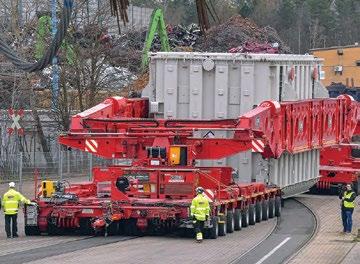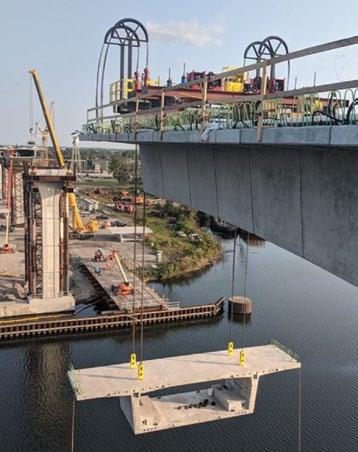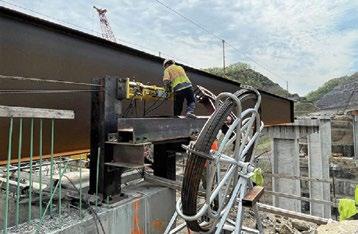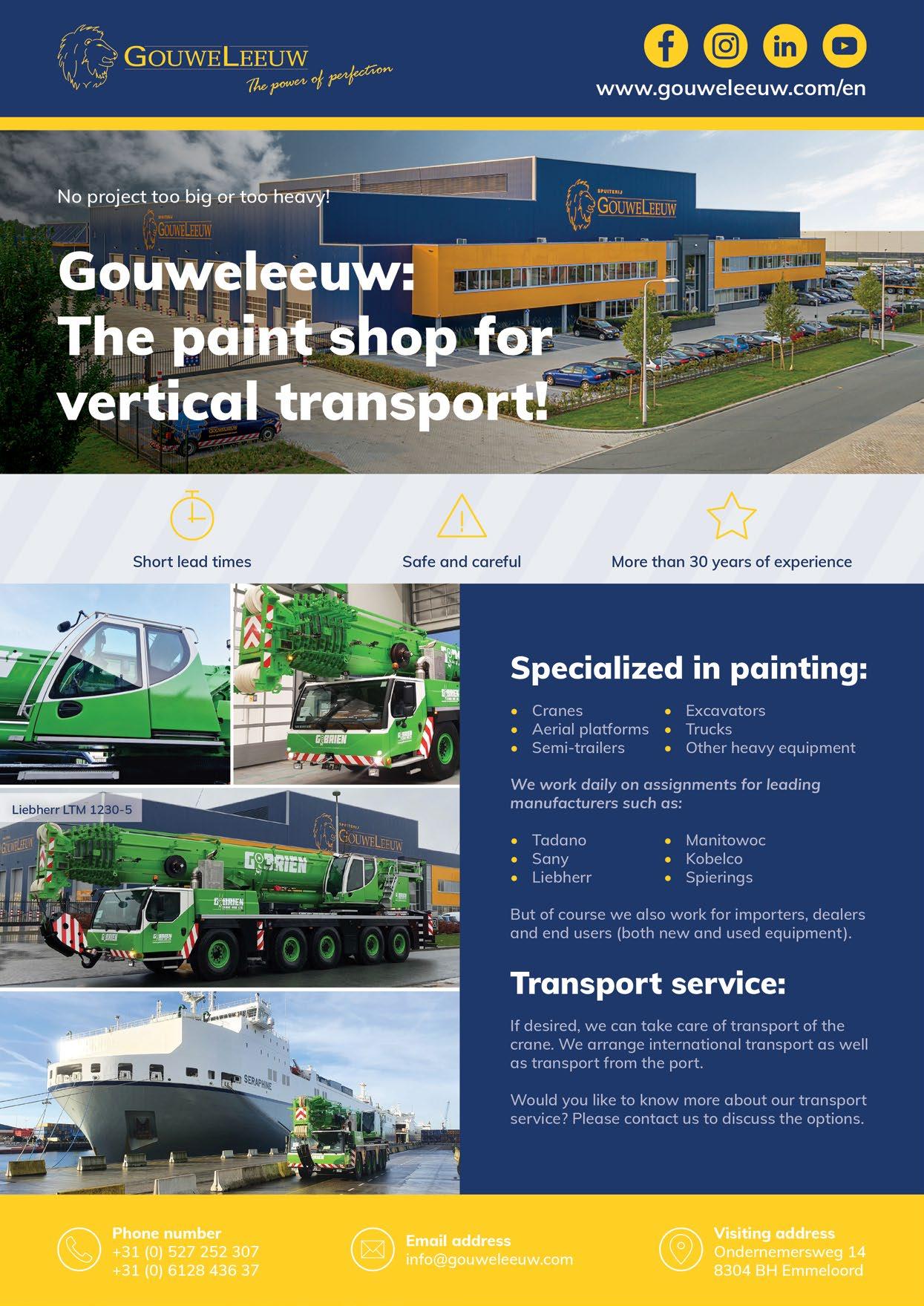
8 minute read
THE ABC OF LIFTING WITHOUT CRANES
THE ABC OF LIFTING WITHOUT CRANES
The growing preference to construct as much as possible off-site by prefabricating modules in factory type setting, is leading to building larger and heavier components, all of which need to be moved and lifted into place. As a result contractors are looking for innovative alternatives to big cranes which are in short supply or require more space than is available.

Offsite production is nothing new, oil rigs have been built in production yards for more than half a century as have power station components and more recently wind turbines. Over the years lifting equipment manufacturers and heavy lift and rigging companies have risen to the task devising innovative solutions to handle the heavier loads. In this feature we cover just a few examples of engineering ingenuity showing some alternatives to using large cranes. While heavy lift companies are managing to keep up with handling the larger modules, the challenge now is transporting them on the world’s road networks. As one European heavy lift company put it: “We have the capability of building these massive components, but are rapidly getting to the stage of not being able to transport them due to an inadequate road infrastructure.” This issue is discussed on page 30 with input from ESTA - the European association for the abnormal road transport and mobile crane rental industry. The problem is exacerbated by a growing number of bridges in a state of disrepair, leading to reduced axle weights and permitted loads.
This issue is possibly even worse in the United States, with the American Society of Civil Engineers (ASCE) reporting that 42 percent of the country’s 617,000 bridges were built more than 50 years ago, and of those almost 20 percent are structurally deficient. The sheer number of bridges needing to be repaired or replaced has led to a new methods of construction such as Accelerated Bridge Construction (ABC), which according to the Federal Highway Administration is a process that involves constructing large sections of bridges offsite, then installing them quickly, often within 48 to 72 hours, helping reduce road closures, traffic delays and overall project costs. Thankfully the new structures are also being designed to have long service lives.

According to the Administration there are three ABC technologies employed:
• Prefabricated Bridge Elements and Systems with bridge components - the deck, beams and railings - built offsite or adjacent to a site and then installed in place.
• Slide-In Bridge Construction - installing the prefabricated elements or replacing an existing bridge with a new one.
• Geosynthetic Reinforced Soil-Integrated Bridge System - a method for constructing abutments and approach embankments that are less likely to create the common issue of a bump at the end of a bridge.
While this speeds up the bridge replacement times - especially the actual installation - it does not mean the whole process is quick. The design and engineering phases can take a significant time since everything has to be perfect for the installation to go smoothly. However, the many benefits also include improved safety, lower construction costs, reduced environmental impact along with a higher quality, longer lasting structure.
The Texas Department of Transportation says: “The ABC method marks a paradigm shift in the project planning and procurement.”


A distinguishing factor of ABC is that it utilises Ultra-High Performance Concrete (UHPC), which is exceptionally strong and durable resulting in a longer bridge life. According to the Federal Highway Administration (FHA), “UHPC has been used in prestressed concrete girder simple span bridges, precast concrete deck panels, and field cast connections between prefabricated bridge components. The mechanical and durability properties of UHPC make it an ideal candidate for use in developing new solutions to pressing concerns about highway infrastructure deterioration, repair and replacement.”
Engineered rigging
One company that specialises in ABC is Engineered Rigging which has locations in North and South America as well as Europe. Its co-founder and principal Eddy Kitchen says: “When it comes to streamlining the planning, procurement and construction portions of bridge projects, our clients appreciate the fact that we provide the engineering services, specialist equipment rental and technical support. By offering this trio of services under one roof, we can save bridge contractors time and money.”

Resources critical to its success include detailed planning by engineers with the relevant knowledge and experience, the specialist equipment to transport the prefabricated concrete elements and then lift or lower them into position, not to mention the highly trained technicians skilled at operating the equipment and understanding the concept.
“We have extensive first hand experience in Accelerated Bridge Construction,” says Kitchen. “Our engineers have developed detailed lift plans for the placement of bridge decks and bridge trophies as well as their demolition. We also have a team of heavy lifting professionals to provide on-site technical support.”

The company’s rental fleet includes a 2,200 ton jack-up system, strand jacks, sling adjusters (synchoists), self-propelled modular transporters (SPMTS) and a custom built Cantilever Segmental Bridge Lift.

Pond Creek Bridge
A recent contract which highlights the approach was the construction of the Pond Creek Bridge on US460 in Pike County, Kentucky. Incremental bridge launching is ideal when a bridge is very high and access for cranes is difficult or impractical. Contractor Bush and Burchett of Allen, Kentucky, constructed what would become the tallest bridge in the Bluegrass state and one of the highest traffic bridges in the country. The rugged terrain on site coupled with a bridge height of nearly 100 metres created several challenges.
According to Paul Burchett, co-founder of Bush & Burchett: “Being 324ft /98 metres high and 1,000ft (305 metres) long, the slopes on each side of the bridge were extremely steep making conventional crane erection almost impossible.” Bush and Burchett determined that the safest and most economical strategy was to build the steel bridge on the embankment and incrementally move the girders into position onto the eight sets of piers. Engineered Rigging brought in a range of equipment, including two 63.5 tonne HSL7006 strand jacks, a SLPP7E strand jack pump system, strand guide, strand recoiler, gold box, a laptop and industrial Hilman rollers. Engineered Rigging also provided an on-site technician to operate the strand jack system.
As one section of girders was completed in the launch bay, the strand jack system pulled it onto the bridge pier, thus allowing the next section of the bridge to be constructed on the embankment. In total, 10 jacking evolutions were necessary to pull the entire bridge into position. The pulling weight for the first pull was approximately 7.3 tonnes and increased with each subsequent pull reaching 36.3 tonnes.
The pulling force is a function of how easily the bridge slides on the rollers and on the dead weight of the steel span.

“The launch went as well as we could have imagined,” said Burchett. “We encountered a few challenges during the launch related to the small tolerance margin. On the piers, we only had about a half inch (12.7mm) of tolerance with each gap. Any lateral movement or minimal inconsistencies in fabrication of the girders or rollers leads to rollers not lining up with the gap in the splice plates. While this caused a bit of a delay on the eastbound launch, we modified the splice plates on the westbound bridge that helped reduce the frequency of these issues.” Once the launching of the bridge was complete, it was lifted off the Hilman rollers and lowered onto its bearings. This step of the bridge construction process used additional Engineered Rigging heavy lifting equipment including one SFP421SJ split flow pump, hydraulic hoses, four 145 tonne LPL1602 locking pancake jacks and four HCL1006 90 tonne locknut cylinders.
“This was the first time a girder launch has ever been performed in Kentucky, and I was glad to be a part of it. We would definitely use the approach again if the conditions called for it. The designer, Stantec led by David Depp, Engineered Rigging and the inspectors from the Kentucky Transportation Cabinet did a great job working with us to make this happen.” ■














